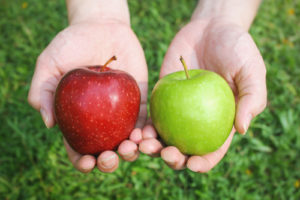
The nutritional value of Apples

An apple a day keeps the doctor away! While the well-known proverb might not exactly hold true there’s no doubting that apples are pretty good for us.
Variety
There are around 7,500 varieties of apple grown worldwide, which come in various shades of red, yellow and green. Up to 3,000 varieties of the fruit are grown in the UK alone, with a similar number being grown in America. Apples are also relatively cheap and are readily available. They also come in an array of tastes and textures, varying from juicy to firm and sweet to tangy. Traditionally, apples are in season in the UK from September to February. However, with improved growing techniques and cold storage facilities, that has now changed. Today, a large variety of British apples are pretty much available all year round.
Red or Green?
All apples are relatively high in nutrients regardless of their colour. However, red apples can contain up to five times more anthocyanin than green. A compound that has been linked to heart-health and cholesterol-lowering benefits. Some types of red apple have been shown to have more fibre, calcium, magnesium, phosphorus, potassium, and vitamin K, than green varieties. However, Granny Smith apples have been shown to contain more vitamin A than their red counterparts. Nevertheless, all varieties of apple are good choices for adding antioxidants and other nutrients to your diet.
Recent Studies
Various other studies have also shown that eating an apple can reduce the levels of LDL or ‘bad’ cholesterol in our blood. One study showed that including an apple in your diet for just 4 weeks was enough to reduce LDL levels in the blood. This benefits health in as much it reduces the risk of heart disease. Apples can also be beneficial as part of a weight-loss diet since they contain pectin. The soluble fibre helps to slow the digestion process, thus creating a sense of feeling fuller for longer. Apples have also been shown to control swings in blood sugar levels, thus reducing the risk of Type 2 diabetes.
Italian studies have also indicated that apples may also help to reduce the risk of certain cancers, since they are generally high in antioxidants. The study found that incident of throat, pancreatic, bowel, breast and ovarian cancers may well all be reduced by eating apples. Also, found in the apple’s skin, are cancer-fighting compounds, called triterpenoids, Vitamin A, C, and K, and around half of the fruit’s overall fibre content. So, some good reasons to never bother with peeling an apple.
Did you know?
A medium-sized apple, as well as being a good source of vitamin C and potassium, provides around:
- 95 calories
- 4 g fibre
- 25 g carbohydrate
- 1 g protein
- 19 g sugar (naturally occurring)
Have you enjoyed reading this article? If so, why not look up some of our other food features and menus in our Food & Drink section, by clicking on the provided link.





